Making movies. Enjoying movies. Remembering movies.
A year-by-year, film-by-film history of 70-millimeter wide gauge exhibition in New York City & Vicinity
Compiled by Michael Coate and William Kallay
continued
Promotional Ads
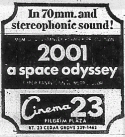 Films released in the 70mm format, whether they were released during the
Roadshow Era or during the blow-up era, were usually promoted with hype in
local newspapers and on the theatre marquees. The ad lines reflected the
eras in which films were released. Some good hype lines included “You’re
In The Show With Todd-AO!,” “In Breathtaking 70mm,” and “In the Splendor
of 70mm Wide Screen and Full Stereophonic Sound.” And for some post-1962
70mm presentations, “Presented In Cinerama” was used for a number of
films, particularly those filmed in Ultra Panavision. (Between 1952 and
1962, Cinerama was a 3-strip multi-panel format. Thereafter, it was a
single-strip 70mm process, but still promoted as a Cinerama experience.)
During the 1970s, 70mm advertising became low key. Though the format was
touted in newspapers, it was usually given a small font size. In other
words, no longer did ads tout Todd-AO or Super Panavision 70. Large-format
production came to an end, and the few blow-ups that came out at the time
had low key advertising in newspapers. The 70mm format ads became rather
generic. Ads
Films released in the 70mm format, whether they were released during the
Roadshow Era or during the blow-up era, were usually promoted with hype in
local newspapers and on the theatre marquees. The ad lines reflected the
eras in which films were released. Some good hype lines included “You’re
In The Show With Todd-AO!,” “In Breathtaking 70mm,” and “In the Splendor
of 70mm Wide Screen and Full Stereophonic Sound.” And for some post-1962
70mm presentations, “Presented In Cinerama” was used for a number of
films, particularly those filmed in Ultra Panavision. (Between 1952 and
1962, Cinerama was a 3-strip multi-panel format. Thereafter, it was a
single-strip 70mm process, but still promoted as a Cinerama experience.)
During the 1970s, 70mm advertising became low key. Though the format was
touted in newspapers, it was usually given a small font size. In other
words, no longer did ads tout Todd-AO or Super Panavision 70. Large-format
production came to an end, and the few blow-ups that came out at the time
had low key advertising in newspapers. The 70mm format ads became rather
generic. Ads
 |
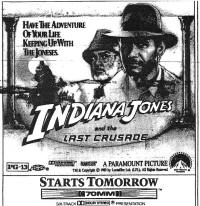 |
In this day of movies opening on thousands of screens at one time, it might be hard to believe that roadshow films released in the mid-1950s to the early 1970s usually played in one theatre during its initial engagement. Citywide 35mm releases were distributed around town many months to a year later. Ads for these types of 70mm films promoted the film’s presentation format almost as much as the film itself. Scaning through the area newspapers, the words “Todd-AO” and “Cinerama” (single lens) pop out at the reader, hopefully enticing them to take a subway into Times Square to see a film in 70mm. For some people, perhaps it was just as exciting to see the latest Charlton Heston epic, but also see it in 70mm.
As you read through the following list of engagements, you may be surprised by the omission of certain titles known or believed to have had 70mm presentations somewhere around the country. Even though New York was a huge market, some distributors for whatever reason supplied only 35mm versions. As an example, “55 Days At Peking” (1963) and “Custer Of The West” (1968), both of which were 70mm roadshows in other U.S. cities, appear to have been shown in the Big Apple as 35mm continuous performances. In addition, a number of American productions (or American co-productions) were shown in 70mm outisde the U.S. but in 35mm domestically (such as "Zulu" and "Guns For San Sebastian"). But to balance things out, New York was privileged to play some 70mm exclusives. There are other films believed or rumored to have been shown in 70mm that some readers may notice are absent from the list. But due to inconsistencies in our references or what we believe to be erroneous information appearing in published sources, more research is required to justify such titles being included (see our “Mystery List” addendum).
Going further into the “70mm In NY” list, you may notice that we’ve included the theatre chain names,
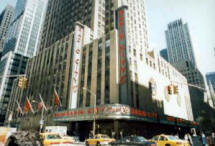 |
and that the names changed quite often over the years. We’ve attempted to include this data based on the time of the engagement and any inconsistencies are a reflection of the ads themselves. For instance, Loew’s, is listed two ways. During the Roadshow Era, it was listed as “Loew’s,” referring to founder Marcus Loew. But by the 1980s, the chain was referred to as “Loews.” We make note of this to hopefully avoid confusion. Some might think that the missing apostrophe is a typo, which it is not in our case. Also, other theater chains, like the Walter Reade chain, either bought or merged with other companies. You will see in this list references to Walter Reade listed as “Walter Reade-Sterling” for a short period of time during the 1960s.
As you read through the entries of 70mm engagements, please note that we’ve included, on occasion, short “hype” lines from the newspaper ads themselves. For instance, you might come across bold lines like, “The Mightiest Motion Picture Ever Created!” Or “New York’s Only East Side Theatre Equipped to Show 70mm.” Wondering what films those came from? Read on.
70mm Engagements In NYC
So why go through the trouble of compiling a list of 70mm engagements in the Big Apple? For the magazine Widescreen Review, we initially compiled a list of 5-perf 70mm films exhibited throughout the world. This list first appeared in 2000 in a special edition of the magazine called The Ultimate
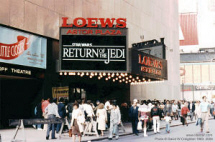 |
Widescreen DVD Movie Guide and later on the in70mm.com website. Soon after that, we compiled a list of 70mm presentations in Los Angeles. Thus, it stood to reason that we should compile a list of 70mm engagements in another large U.S. market: New York. For those who have lived in the New York City area, we hope this brings back a sense of nostalgia and memories associated with seeing 70mm presentations. Also, we feel it’s now a historical record and deserves to be accounted for.
Other researchers have shared their enthusiasm by compiling lists of 70mm engagements in cities such as London, Toronto, Sydney, and Mexico City. And don’t forget our very own San Francisco and San Diego projects. You might ask, where’s Chicago, Dallas, Seattle, and how about Washington, D.C.? Given that it’s taken us years just to finish these lists for Los Angeles and New York City, we don’t have a problem with anyone willing to tackle those cities. Just remember, we’ve looked at every week of newspaper ads for the era, plus referenced books and industry magazines and spoken to a number of people just to get to this point. We’ve spent countless hours revising and adding information to this list. It’s not rocket science, but it’s certainly time consuming. We enjoy doing this research, and hopefully, our enthusiasm is reflected here for you to read and research 70mm presentation for yourself.
Why Was 70mm Presentation Important? Regardless of where a 70mm print was shown, the larger film format provided exceptional quality. Seeing “70mm” on a marquee usually meant that audiences would get a great presentation in both sound and picture. It was a format that excelled in the manner audiences experienced a film presentation. Bigger film usually equaled better image quality on the big screen. Even run-of-the-mill
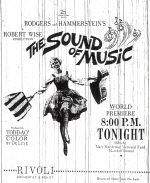 |
Clear, sharp and beautiful wide gauge images graced large screens in New York City and vicinity for over 40 years. There have been sporadic 70mm presentations in Manhattan in the last few years, but since the advent of digital movie sound and the megaplex construction trend during the ‘90s, 70mm
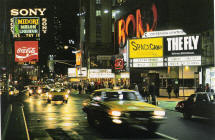 |
has, essentially, become extinct in commercial presentation. As much as fans might mourn the loss of this great format, perhaps we can take solace in the fact there is now a list to remind moviegoers how great New York-area 70mm exhibition was.
As great as wide gauge film presentations can be, a 70mm print in a booth was not a guarantee of a perfect presentation. This has been especially true in recent years with the increased use of automation and non-union projectionists. In the hands of a professional projectionist, and with adequate promotion, 70mm is an unparalleled theatrical experience.
Manhattan is a film lover’s town. Scanning through ads, the town had an appreciation for nearly every type of film. Woody Allen and Charlie Chaplin were given retrospectives on occasion. Art films, experimental films and documentaries received engagements around town. Even pornographic films were advertised in The New York Times and seemed to be very popular in the 1970s. It stands to reason that 70mm presentations added to a variety of moviegoing options for New Yorkers. Reserved Seat Engagements In this day of convenience, it is easy to overlook the reserved seat concept once in use by the industry. Reserved seat engagements were popular in the Roadshow Era, whereby you could purchase a ticket either by mail, phone or in person at the box office and often many weeks in advance of a film’s release. The reserved seat ticket guaranteed you a specific seat in the auditorium playing a roadshow film, like “The Sound Of Music.” Since many theatres of the day, both old and new, had large seating capacity, often you could buy a ticket in the balcony, mezzanine or orchestra section. This is similar to buying a ticket for a concert, a Broadway show or a sporting event. The roadshow concept offered an event-like experience to going to the movies, particularly when one factors in the exclusivity of the engagement, the one-show-per-night, the higher-than-normal ticket price, the curtains, the overture, the intermission, the stereophonic sound, and so on. These trimmings were not, generally, a part of the every-day moviegoing
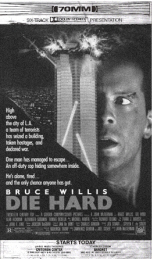 |
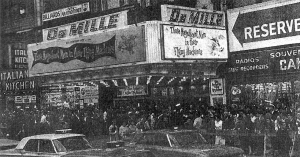 |
The List Of 70mm Cinemas In NYC
While this project has focused on the 70mm engagements in New York, we’ve also included a list of cinemas equipped for 70mm film presentations in the region. The New York metropolitan area had over 100 theatres equipped for 70mm projection at one time or another, with Manhattan alone accounting for several dozen.
And Why Are You Guys So Obsessed About 70mm? Why the obsession with a virtually dead film format in this day of digital cinema and digital picture taking? Well, why wax nostalgic over a bunch of dead baseball players? Or why pine for the Brooklyn Dodgers? Because there’s a little part in some of us who yearn for the so-called old days, when things seemed better than they probably were. There’s something satisfying, perhaps, in remembering when some baseball players weren’t selfish, overpaid grown men who can act like babies. Or there’s something satisfying about afternoons out at Ebbets Field watching the Bums play ball. Of course, there have always been selfish ball players and Ebbets Field certainly cannot compare to our newer luxurious stadiums with great site lines and comfortable amenities. Yet there were creature comforts about those old days that many of us enjoy in our minds. Most theatres built today, though often advertised as “state-of-the-art,” seem inferior to those classic theatres in which we experienced 70mm. The picture, if a widescreen (scope) film is shown, is often smaller than it should be due to common-width screens and clever masking. The sound is often not as good as magnetic multichannel sound once prevalent on 70mm prints. Isn’t it odd that much of what we experience today in entertainment, sports and even automobiles is a throwback to the “good ol’ days”? Many movies have their stories told through the pages of 40 year-old comic books. Occasionally, sports teams don “retro” uniforms for games. Daimler-Chrysler has introduced a line of cars and trucks with a “Hemi” engine under the hood, a throwback to the old days. Why revive an old engine idea when we can have hybrid cars to drive? Because it’s cool, that’s why! Hence, this is why we love 70mm. Conclusion We hope you enjoy this trip through time when the Big Apple and its surroundings were the place to see 70mm. As Southern California natives, it was exciting for us to go outside of “our” world and visit another. The ads, the theatres, the size and scope of 70mm presentation in New York should not be underestimated. Today, many in the industry think that 70mm wasn’t popular or was rarely shown. On the contrary, one only has to look at this list of 70mm engagements to see how popular the format was in New York City and its surrounding areas. Now that you’ve been so kind as to read our introduction, please allow the curtains to part and immerse yourself in “70mm In New York.”
Search 70mm Engagements By Year

